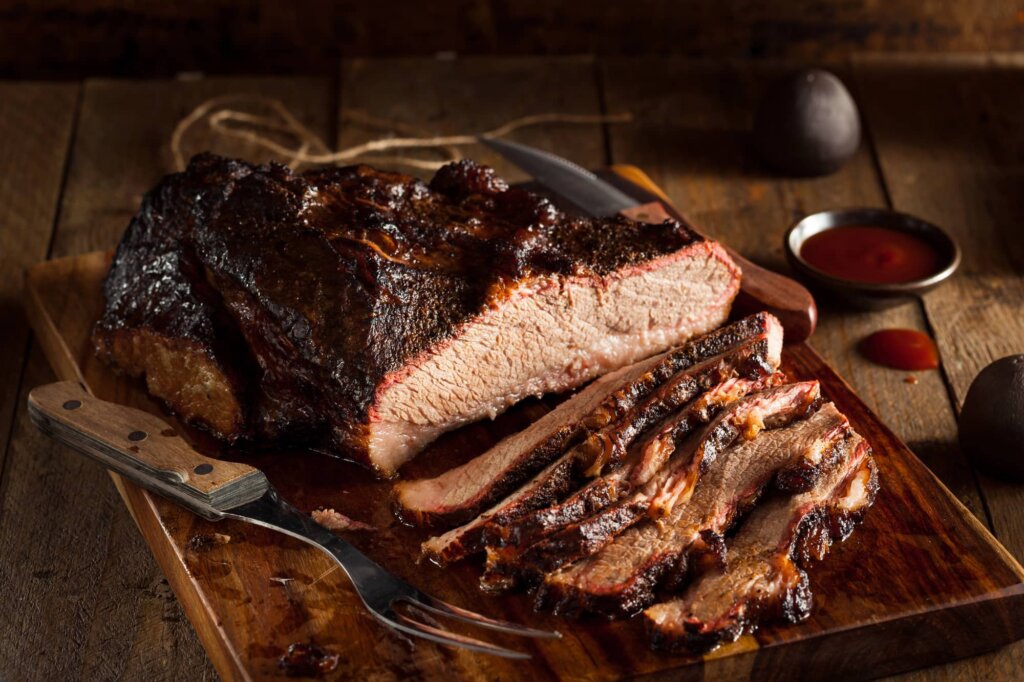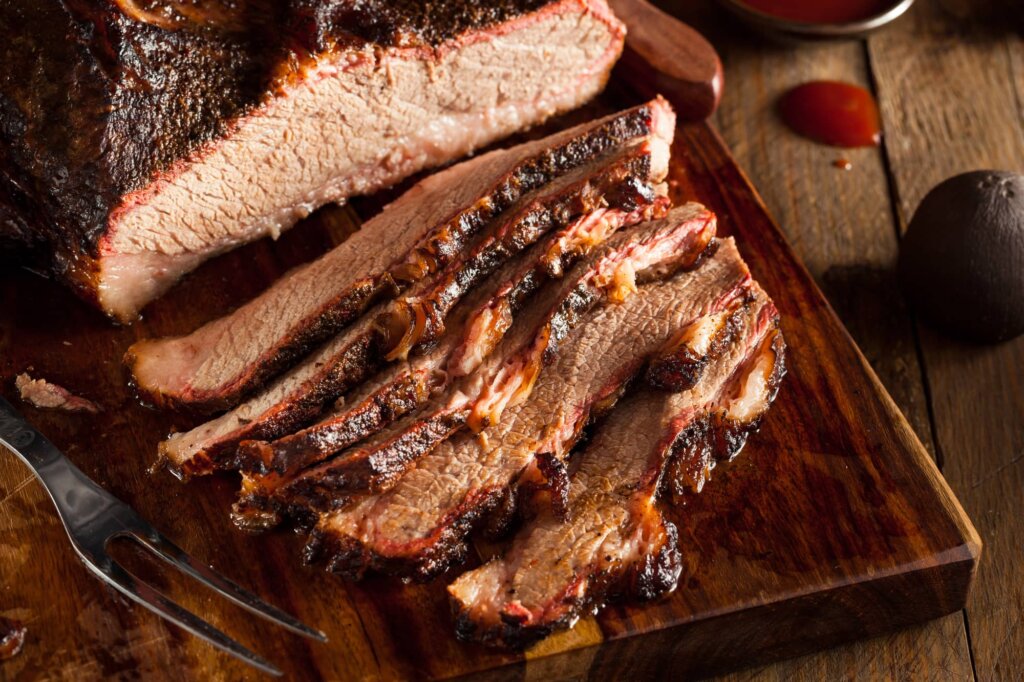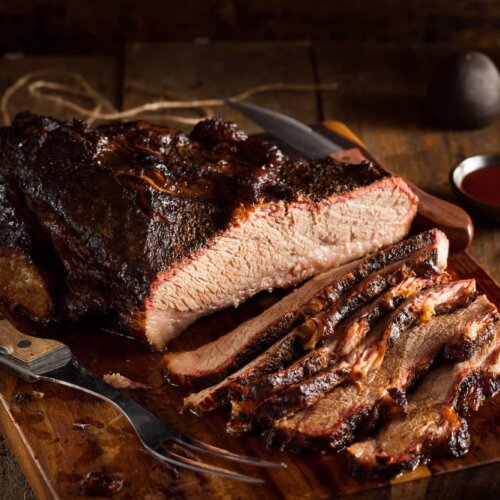
The classic beef brisket can weigh over 20 pounds, at least before it goes into the barbecue pit for hours of smoking. Yet there’s no need to cook that much meat at once or transform your backyard into a smoker’s paradise just to enjoy the rich taste of this cut. You can use your oven to do all the hard work indoors while you kick back and relax. Whether it’s winter and you’re craving crispy-edged brisket or you don’t have the patio space for a smoker, this method is sure to help you achieve your beef cooking goals.
Why Cook Beef Brisket “Low and Slow” in the Oven?
Beef brisket is a large cut of meat, even when you buy a piece that has been divided from its original and quite large size. It’s far too thick for cooking methods like pan frying, but it can be tricky to cook without getting tough or dried out when using a high-heat method like the grill. Low and slow cooking is the key to getting the dense grain of this cut of beef to relax into a tender and flavorful bite. Oven cooking is also more relaxed and less attention-demanding than using a grill or smoker for the same process. You can stay indoors rather than battling less than pleasant weather, meaning you’ll never have to reschedule your barbecue plans again. It’s also easy to check the beef brisket regularly when it’s nearing the end of its cooking time without losing too much heat from opening and closing the oven.
Tips for the Perfect Oven Brisket
While the oven is a great appliance to use to cook beef brisket, you still need to use the right techniques to get the best results. A perfect brisket is cooked to well-done because this particular cut won’t be tender or very flavorful if only cooked to medium to medium-well. But this shouldn’t mean that the brisket is dry when it’s done. Starting with a brisket with plenty of fat on the outside is the key, along with using the right kind of pan for holding the meat when it’s in the oven.
Choosing the Right Cut
The full brisket is a massive hunk of beef that can easily weigh 15 to 20 pounds. The whole cut is not a great choice for cooking at home in general, especially in the average oven. You’ll find that the outside will get far too overcooked before the inside portion reaches a completely tender texture. Very small brisket trims, such as the 1 to 2-pound pieces you can find in many grocery stores, will have the opposite problem of drying out before the exterior gets much of a crisp to it. For the best results, look for a brisket cut that includes about ½ of the whole piece. This will weigh around 5 to 12 pounds depending on the specific cut. When a brisket is cut into two halves, they’re named for the shape of the tip they include. Flat briskets are thinner and include less fat, which makes them less than ideal for this method of cooking. Look for the thicker and heavier section known as the point cut, which should have a nice layer of fat over the top. This will ensure you get plenty of rich flavors and juiciness even with a slow and low cooking method.
How to Season for Best Flavor
Marinating isn’t a very effective way to add moisture or flavor to this cut of beef due to its size, thickness, and texture. A better alternative is dry brining, which is a simple technique that only requires your refrigerator. Simply unwrap the brisket and place it in the roasting pan where you’ll cook it. Rub the entire surface with kosher salt, aiming to get an even coating of salt over the whole surface. Then simply add a seasoning rub that has no salt in it right before cooking and you’ll get the best flavor without much extra effort at all.
Cook Covered or Uncovered?
The answer to this question is actually both. You’ll want to start out cooking the beef brisket with no cover on. This allows you to put a good crisp surface on the meat, also known as the bark. Once the bark gets a chance to develop, you’ll add liquid to the roasting pan and tightly cover it with the lid so the steam gets a chance to circulate around the meat. This ensures the finished brisket isn’t too dry, but it still creates a flavorful bark that has the texture you expect. If your roasting pan doesn’t have a tight-fitting lid of its own, you can use aluminum foil in a pinch.
Check the Temperature Accurately
You won’t be aiming for a highly specific temperature range for brisket because it needs to be well done to have the texture you want. However, going much above the 180-degree F point will result in meat that is tough or dry. An accurate meat thermometer is a must-have for cooking any type of beef, including when you cook beef brisket. Make sure your oven temp is accurate as well by putting in a separate thermometer that’s just for tracking the cooking temperature. It’s not unusual for home cooks to discover their oven is 10 to 20 degrees off from the desired temperature, which is easy enough to adjust to once you know.
Rest Meat Before Carving
Never carve a freshly cooked beef brisket or you’ll lose a lot of moisture and flavor. Briskets need a minimum of 30 minutes of resting to redistribute the juices, reach the final texture, and develop the full flavor. Rests of 2 hours or more aren’t uncalled for when you want a sliceable texture rather than beef that pulls apart at the touch of a fork. In fact, some home cooks prefer to let the meat rest overnight in the refrigerator if they’re after perfect and uniform slices of brisket for sandwiches or other recipes.
How to Slice Oven-Baked Brisket
After giving the brisket a generous rest, you’ll need a long and serrated knife. A bread knife will work well if it’s sharp, but you may want to buy a dedicated brisket knife if you plan to cook them regularly. A 12 to 14-inch blade length is recommended so you can cut even the largest piece of meat in a single pass. You need to cut against the grain when slicing. Trim a corner off to check which way the fibers of the meat are running, then align your cuts so they go right across that pattern. Aim for half-inch thick slices, taking your time to move the knife back and forth without too much downward pressure so you’re slicing rather than forcing or tearing the meat apart. Only slice what you plan to eat since leaving the rest intact will preserve its flavor and moisture.
Oven Cooked Beef Brisket Recipe

Ingredients
- 6 to 10 lb brisket, point cut preferably
- 1 teaspoon of dry mustard
- 1 tablespoon garlic powder
- 1 teaspoon onion powder
- 1 tablespoon cracked black pepper
- 1 tablespoon brown sugar
- 1 quart of beef broth or stock
- 3 to 4 tablespoons of kosher salt
Instructions
1. Place the brisket in the roasting pan on a rack one day before you plan to cook it. Rub the salt over the surface of the meat, only using enough to get an even but not overly thick coating. Let the brisket dry brine overnight in the refrigerator with a lid over the pan.
2. Take the brisket out of the refrigerator about 1 hour before you plan to cook it so it can come to room temperature. After about 45 minutes, preheat the oven to 350 degrees F.
3. Mix the seasoning ingredients together and rub them onto the surface of the meat. Don’t worry about any salt you knock loose in the process. Put the brisket in the oven.
4. Let the brisket roast uncovered for 1 hour. Take the roasting pan out and add the beef broth or stock so there is at least ½ inch of it in the bottom of the roasting pan. Lower the oven temperature to 275 and place the lid on the roasting pan. Continue cooking for up to 2 hours longer, until the brisket has an internal temperature of 180 degrees F.
Oven Cooked Beef Brisket – Nutritional Facts
Per Serving (8.5 oz Cooked Brisket with Rub, Based on a 2,000-Calorie Daily Diet)
| Nutrient | Amount (% DV) |
|---|---|
| Calories | 480 |
| Total Fat | 36g (46%) |
| Saturated Fat | 15g (75%) |
| Cholesterol | 125mg (42%) |
| Sodium | 780mg (34%) |
| Total Carbohydrate | 2g (1%) |
| Sugars | 1g |
| Protein | 36g (72%) |
| Iron | 3.7mg (21%) |
| Potassium | 520mg (11%) |
Conclusion
Become the brisket master among your friends by practicing your skills at oven roasting. With this cut of meat being one of the most affordable types of beef, it’s easy to polish your slow-and-low cooking skills without breaking the budget.

Oven Cooked Beef Brisket
Ingredients
- 1 6-10lbs brisket, point cut preferably
- 1 tsp dry mustard
- 1 tbsp garlic powder
- 1 tsp onion powder
- 1 tbsp cracked black pepper
- 1 tbsp brown sugar
- 1 quart beef broth or stock
- 3-4 tbsp kosher salt
Instructions
- Place the brisket in the roasting pan on a rack one day before you plan to cook it. Rub the salt over the surface of the meat, only using enough to get an even but not overly thick coating. Let the brisket dry brine overnight in the refrigerator with a lid over the pan
- Take the brisket out of the refrigerator about 1 hour before you plan to cook it so it can come to room temperature. After about 45 minutes, preheat the oven to 350 degrees F
- Mix the seasoning ingredients together and rub them onto the surface of the meat. Don’t worry about any salt you knock loose in the process. Put the brisket in the oven
- Let the brisket roast uncovered for 1 hour. Take the roasting pan out and add the beef broth or stock so there is at least ½ inch of it in the bottom of the roasting pan. Lower the oven temperature to 275 and place the lid on the roasting pan. Continue cooking for up to 2 hours longer, until the brisket has an internal temperature of 180 degrees F

